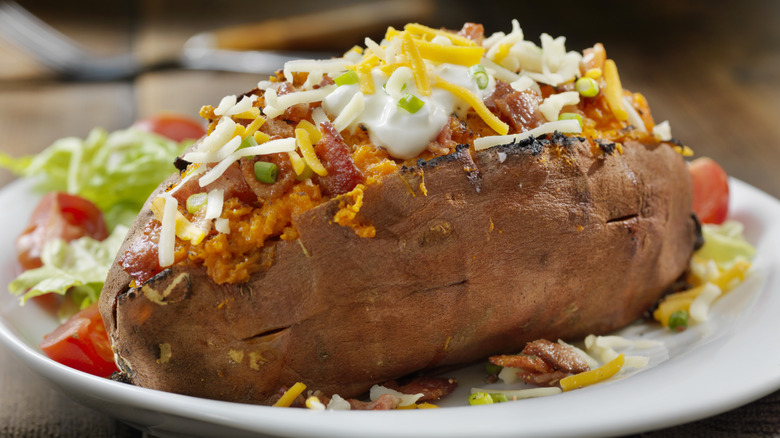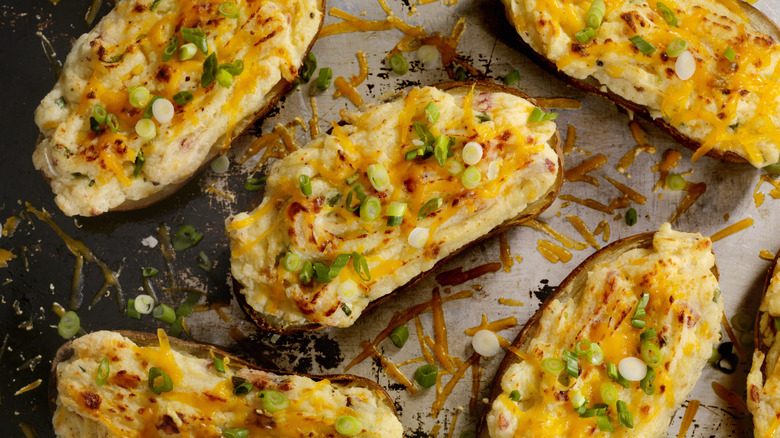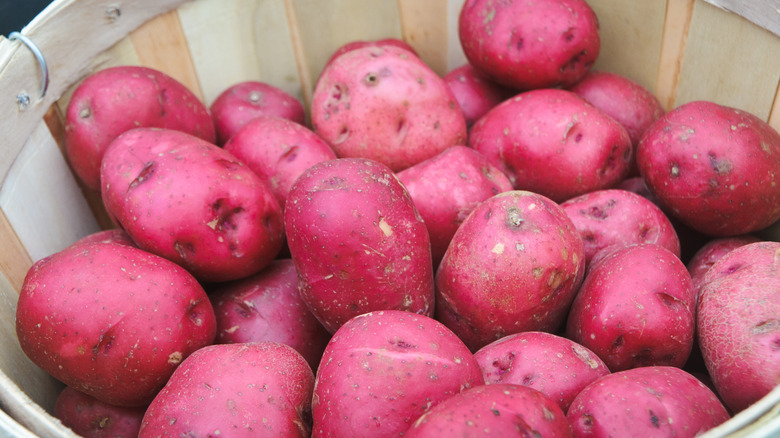When It Comes To The Perfect Baked Potato, Always Avoid Red Varieties
Whether making it as a side dish or preparing it as an entree topped with enough fixings to keep you full for days, baked potatoes are satiating, easy to make, and versatile. But with versatility comes endless options, and if you're indecisive, it can quickly become an overwhelming task. And when it comes to baked potatoes, it's not just the toppings that are customizable, it's the potato itself. That said, as long as you follow one simple rule of thumb — never use red potatoes — your baked spuds will turn out fine.
First off, red potatoes are generally smaller than other varieties, which poses a challenge when you want to top your baked potatoes with a generous amount of garnishes — and what's a baked potato without a fair share of butter, cheese, and bacon bits? It's not just the size of the spud that will influence the quality of your baked potato recipe, it's also its texture. Red potatoes are waxy, dense, and have a low starch content which leads to a baked potato with a compact interior instead of one that's fluffy and mealy like a proper baked spud should possess.
Red potatoes have a more prominent flavor than other varieties, and while this is great for certain dishes, baked potatoes are better when prepared with spuds with a mild, neutral taste as a backdrop. Using potatoes with a naturally unremarkable flavor is like having a blank canvas primed for painting with a wide variety of flavors and fixings.
The best spuds for baked potatoes
Red potatoes are out, but which varieties are in for crafting the best batch of baked potatoes? You'll want to make your potato selection based on two defining characteristics – low moisture and high starch content. Following this simple guideline, you'll have a fluffy, light, and downright high-quality baked spud every time.
One of the most common varieties for baked spuds is a good old-fashioned russet potato, which yields a batch that's soft and airy on the inside and crunchy and crisp on the outside. Plus, their oblong shape provides ample space for loading the baked delicacy with plenty of toppings — no hanger pangs after this starchy meal! After all, even Rachel Ray uses russet potatoes for her overstuffed twice-baked potatoes.
However, it's not just russets that make for excellent baked potatoes. Paula Deen opts for Idaho potatoes in her family-style baked potatoes recipe, and if you do want a bite-sized baked potato for a party-approved finger food, Giada De Laurentis uses baby Yukon Gold spuds for her handheld twice-baked potatoes.
Other options for choice baked potatoes are sweet potatoes, Maris Piper potatoes, and King Edward potatoes.
Better uses for red potatoes
Don't worry, we're not here to slander red potatoes. Even though they're not fit for being baked, they still have plenty of uses. So if you have a bag full of red spuds, don't just toss them out, find a way to include them in other potato-centric recipes.
Thanks to their waxy texture that aids in preserving the spud's shape, red potatoes are perfect for roasting. Red potatoes are also an excellent option for potato salad because their low-starch quality allows them to absorb dressings and seasonings while maintaining a firm structure that won't blend in with the creamy mayonnaise used in a classic potato salad recipe. You can also add red potatoes to soups and stews for a hearty, substantial contrast to the liquid consistency of broth.
Put more simply, red potatoes are ideal for dishes that require a potato to maintain its firmness and hold its structure and density without breaking down into a mushy, mealy consistency.


